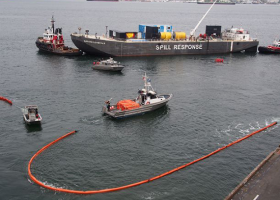Argo Merchant Oil Spill
In the early morning of Dec. 15, 1976, the Liberian tanker Argo Merchant went aground on Fishing Rip (Nantucket Shoals), 29 nautical miles southeast of Nantucket Island, Massachusetts in high winds and ten foot seas.
The vessel was carrying approximately 183,000 barrels of No. 6 Fuel Oil (80%) and cutter stock (20%). The master of the vessel requested permission to dump cargo in an effort to control draft and re-float the vessel. Permission was denied and attempts to lighter and re-float the vessel using emergency pumps and an Air Deliverable Anti-Pollution Transfer System (ADAPTS) were unsuccessful. The following day, the weather worsened and the crew of the Argo Merchant was evacuated.
On Dec. 17, the vessel began to pivot clockwise and buckle. On Dec. 21, the vessel broke in two, spilling approximately 36,000 barrels of cargo. The bow section split forward of the bridge and capsized on Dec. 22, resulting in the loss of the remaining cargo. The bow section floated 400-500 yards to the southeast and was eventually sunk by the U.S. Coast Guard while the stern section remained aground. Prevailing currents carried the spilled oil away from the shorelines and beaches of Nantucket. Weather conditions and uncharted depths surrounding the wreck made salvage attempts difficult.
Photos: View historical images from this 1976 oil spill.
More Information: Learn more about the spill and its response on OR&R's IncidentNews website. You can also read this series of six stories examining this spill, which resulted in the creation of NOAA's Office of Response and Restoration:
- Emergency Response and Assessment 40 Years after Argo Merchant
- Argo Merchant: The Growth of Scientific Support
- Argo Merchant: The Birth of Modern Oil Spill Response
- Tools and Products: 40 Years of Spill Technology
- Argo Merchant: What if it happened today?
- Argo Merchant: A Woods Hole Scientist's Personal Perspective


